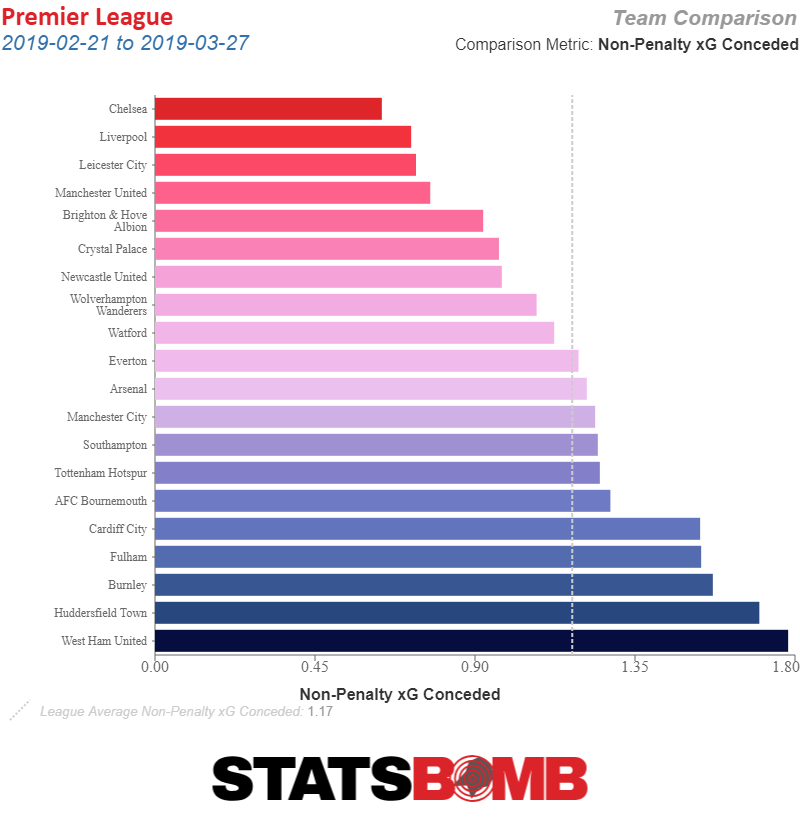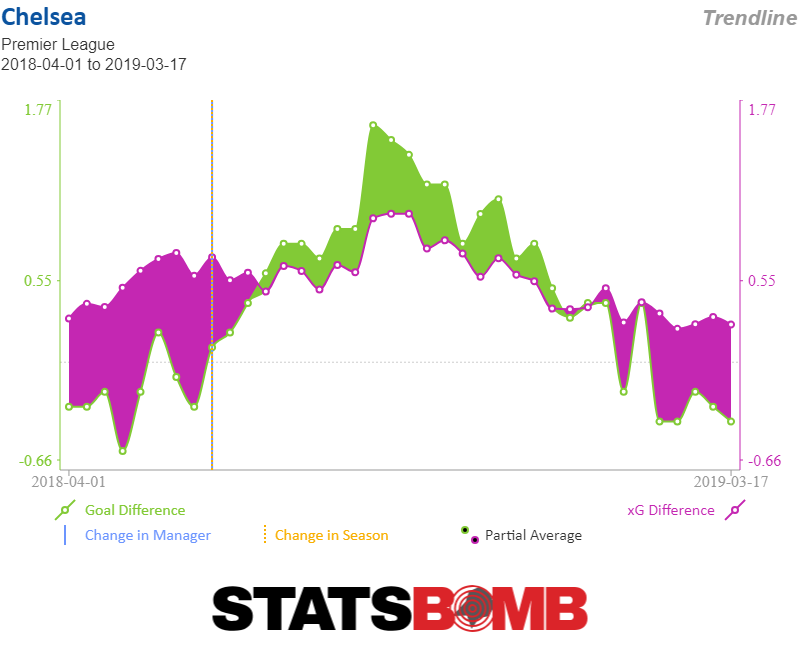Usually when the Premier League crosses the 30 match threshold, teams are what they are. While it’s not impossible for a team to deceive for 80 percent of the season only to come whooshing back to reality, it’s pretty rare. But, that doesn’t mean there’s no uncertainty left. With the title and the Champions League spots hanging in the balance, here are three numbers to watch which might shed some light on how the season’s biggest races will wind down.
Manchester City’s shots
When most great teams have hiccups in form it comes because they struggle to get great shots. A handful of particularly dogged defenses force the favorites to pile hopeful launch on top of hopeful launch, successfully opting to defend against quantity over quality. That’s not what happens to City. For whatever reason, when City struggle, they simply don’t get very many shots. Perhaps Pep Guardiola’s side are so insistent on creating tap-ins in front of empty nets that they simply won’t settle for pot shots, so when a defense prevents those, City just keep butting their heads up against the wall.
Guardiola’s side has only struggled briefly this season, a four game stretch in December when they lost three games, first understandably to Chelsea, then shockingly at home to Crystal Palace and away to Leicester City. But, the alarm bells for that stretch of time started earlier. On November 24th City beat West Ham 4-0, the problem is they took only nine shots while doing it. They followed it up with 15 and 16 shots in wins the next two weeks, numbers that might seem high (and would be for any group of mere mortals) but aren’t for a City side that averages 17.50 shots per match. Then came the struggles.
So, as Liverpool look on and pray for signs of weakness, is anything amiss with City? They keep winning, but two of their last three victories have been accompanied by subdued 1-0 score lines. And, sadly for Liverpool, the answer is no. The side has taken 19, 20 and 23 shots in their last three matches. That’s about as healthy as it gets, even if the goals haven quite matched.
The moral of City’s shooting story is that the team is firing on all cylinders right now. Technically they’re two points behind Liverpool but with a game in hand they control their own destiny, and they’re favorites to defend the title that they won last season. If that ends up not happening it will be because some unexpected struggles set in somewhere in the last eight games. The first place those struggles will be likely to show up is in their shooting.
Tottenham Hotspur’s defensive woes
It hasn’t been a great season for Spurs defensively. Thanks in part to a struggling midfield, Spurs have largely relied on a high speed attack at the front and Hugo Lloris in goal at the back to keep them on track. But there’s a difference between having a defense that’s bad for a top six team, and a defense that’s bad, period. For the last month, Spurs defense has trended towards the latter stages. Over the course of the season Spurs have conceded 1.05 expected goals per match, the seventh best total in the league. Over the last four games, a stretch where they’ve taken a grand total of one point, well, they’ve been a lot worse.

The 1.25 xG per match Spurs have conceded over that four game stretch is way down towards the bottom of the league with only six teams performing worse. And while it’s true that two of those matches were against Chelsea and Arsenal, fellow top six contenders, the other two were shocking losses to relegation candidates in Burnley and Southampton. The drop in form isn’t a result of a particularly skewed stretch of schedule. It’s just a result of a team playing badly.
The good news for Spurs is that they had built up quite the cushion, so even after dropping all these points, they’re still in third place. The bad news is that three teams are within four points of them in a wide open race for the top four. Given how close the race is, if Spurs defense doesn’t improve it’s easy to see them getting overtaken by not one but two teams (especially considering that Spurs have the two hardest matches of the season yet to come with trips to Liverpool and Manchester City on the horizon). On the other hand, if this is just a temporary run of form, and four games is only four games after all, then their lead should be enough to carry them through if they revert to simply being the seventh or so best defensive team in the Premier League.
The Chelsea spiral
Chelsea sit in sixth. They’re four points behind third place Spurs, three points behind fourth place Arsenal and a point behind Manchester United. A look at their aggregate statistics on the season portrays them as a third place team that’s simply gotten unlucky. They have an xG difference of 0.50, the third best in the league. They take 15.60 shots per match, the second most, and they concede only 9.17, the third fewest. Stop looking there and what you see is a team that is simply unlucky. With only eight games left in the season maybe there wouldn’t be enough time for the to claw their way back, but it wouldn’t be for want of trying.
Look deeper though and the worrying trend emerges. Their xG difference is going the wrong direction. A ten game rolling average shows a team that looked as though it peaked relatively early and has gotten worse since. And while that trend is exacerbated by changes in fortune, when Chelsea were performing well they were also running hot, and now both the performances and the variance have changed direction, it seems quite real.

This is doubly concerning given that the hope for Chelsea’s season was that as new manager Maurizio Sarri settled in and implemented his approach Chelsea would improve, rather than regress. Instead, Chelsea’s xG difference over the past ten matches is 0.25, or half of what it is over the whole season. Playing at that level over the next eight games certainly won’t get the job done.
Figuring out the best window to use to predict a team’s future performance isn’t a trivial problem. Broadly speaking using the full season works better in aggregate than using a shorter sample. If you just blindly judged every team by their last ten games then you’d do worse at predicting their future performance than you would if you only looked at the most recent ten game window. But, that doesn’t mean that in every single case the longer view is more accurate, just that it’s comparatively much harder to separate out signal and noise is the window gets shorter.
The distinction is crucial for Chelsea. If that last ten games are truly a representation of where they’re at now, then they’re toast. If the longer window is more accurate, then they’ve got a fighting chance.